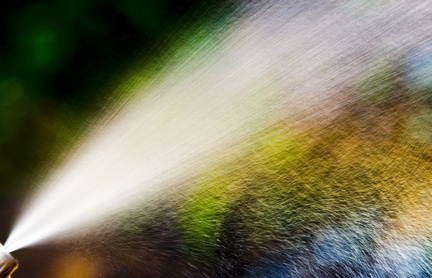
Paint-spray mist, or overspray, on an auto is unsightly. Mistakes happen, such as when you paint an object in the garage while your car sits nearby. Airborne paint particles land on your trunk, hood, door panels or just about anywhere on the auto, which you don't realize until you see it in the sunlight. Paint-spray particles adhere readily to metal surfaces and are quite stubborn to remove, even under the best of circumstances. With some knowledge and use of some common products, the vehicle owner can eliminate any overspray problem.
Look at the paint-spray mist on your auto. If you can determine how long the overspray has been there, and if it has been there for only a short duration, the chances of you removing it without damaging your vehicle's finish can be excellent. Take an ordinary dish-washing sponge, the kind with the very fine abrasive back, and dip it into a pail filled with hot soapy water. Use gloves to avoid burns. Simply apply rubbing strokes up and down, back and forth to the surface. This cross-hatching technique attacks the paint particles from all directions, lifting each particle at every corner. Light spray mist that has been on the vehicle for a short duration should come off with ease.

Take a dab of fine polishing compound, and using four fingers, rub over the affected area with circular motions. Do not apply too much force; use more time than force for the best results. The abrasive quality of the polishing compound will cut or loosen the paint mist particles from the surface. You need only enough pressure to lightly penetrate the clear coat surface.
Apply a thick non-abrasive paste or liquid car wax after the compound. Rub and then buff to a dried finish.
Use a rag soaked in isopropyl alcohol to wipe the affected surface down if the paint mist has been recent. Alcohol has dissolving qualities that remove paint particles, rather than cutting or grinding them. Let the alcohol sit for a minute or two before applying more coats. Alcohol might turn the surface of the clear coat a foggy or a white color. Wipe clean with a damp water rag. Note: Rub in a fine polishing compound to restore the clear coat finish and then apply regular paste or liquid wax as a sealant.

Use a rag wet with acetone for really embedded and cured (dried) spray mist. Be careful not to rub too hard while using this chemical, and always do it in properly ventilated areas. Using a particle mask will help you breathe better. When finished, use a fine polishing compound to smooth out the surface and then apply regular paste or liquid sealer wax.
Obtain an overspray removal kit. Some such kits use chemicals to pull out the spray mist particles rather than cut them out. The chemical in the kit's clay bar does not dry out the original finish, leaves no residue and can be applied on any car's paint.
Use the spray lubricant that comes with the kit to saturate the affected area. Use the pliable clay bar to rub back and forth over the surface several times. The surface will become smoother with each rubbing stroke of the clay bar. Repeat the motions until the bar glides smoothly over the paint's surface. No fine rubbing compound will be needed--only a light coat of paste or liquid finishing wax.